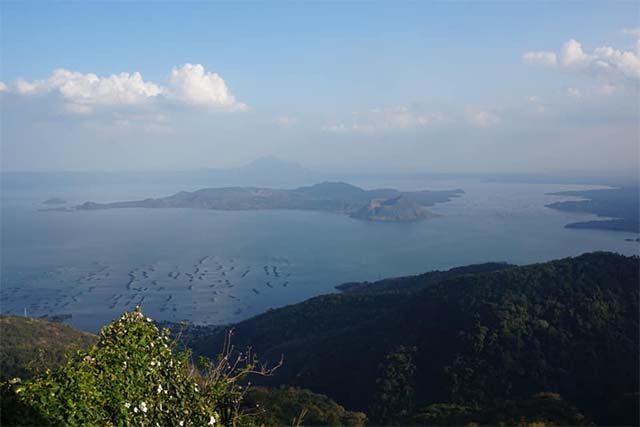
State volcanologists debunked claims on social media that Taal Volcano was allegedly acting up again after pictures and videos of thunderstorms near the area surfaced on Sunday.
The Philippine Institute of Volcanology and Seismology on Sunday evening informed the public that the lightning and thunderstorms were not volcano-related, based on the visual image it has captured from Agoncillo, Batangas.
It included a link of a thunderstorm advisory from the Philippine Atmospheric, Geophysical and Astronomical Services Administration issued at 7:41 p.m. yesterday which told the public to expect “moderate to heavy rainshowers with lightning and strong winds.”
PAGASA added that the condition was to be expected over Metro Manila, Rizal, Pampanga and Batangas “within the next two hours” at that time.
It also said that parts of Cavite (specificallly Naic, Maragondon, Tanza and Ternate), Bulacan (Norzagaray, Angat) and Batangas were experiencing the condition.
Last June, the state weather bureau announced the onset of the rainy season which brings more rainfall in the country. It also signals the typhoon season where tropical cyclones are expected to visit the archipelago.
Meanwhile, Phivolcs included an image of the skies in Taal Volcano taken at 7:46 p.m. on Sunday and reiterated that the thunderstorms were not related to the volcano.
Lightning and thunderstorms observed near Taal Volcano are not volcano-related based on visual image (IP Camera)…
Posted by Philippine Institute of Volcanology and Seismology (PHIVOLCS-DOST) on Sunday, September 27, 2020
Phivolcs on its September 28 Taal Volcano advisory released 8 a.m. said that it has recorded two volcanic earthquakes in the past 24 hour-period. Weak steaming was also observed from its vents on the main crater.
The agency maintained that it is currently under Alert Level 1 status which means that “sudden steam-driven or phreatic explosions, volcanic earthquakes, minor ashfall, and lethal accumulations or expulsions of volcanic gas can occur and threaten areas within the Taal Volcano Island.”
Entry to the Taal Volcano Island, especially the vicinities of the main crater and the Daang Kastila fissure, remains strictly prohibited.
Meanwhile, prior to Phivolcs’ post about the lightning, some Filipinos claimed seeing lightning near the volcano.
Videos and pictures of it surfaced on social media which prompted some people to claim that it was supposedly related to Taal Volcano’s activities.
But it was denied by some Twitter users claiming to live in Batangas.
Stop spreading fake news about the taal volcano please. Yes there is lightning, but it is not from Taal. pic.twitter.com/AA3yzskVcF
— Maxi💎✨⁰³³¹ (@HarutoMyRuto) September 27, 2020
“Ever since last week, Batangas province is really experiencing thunderstorms so let’s avoid spreading news about Taal na unconfirmed or ‘yung feel niyo lang to avoid mass panic because everyone has trauma already,” another Twitter user wrote.
A Twitter account giving updates about weather conditions, earthquakes and volcanic activities also warned the public not to relate the phenomenon of thunderstorms to a Taal eruption.
TO ALL: Please stop spreading false information about Taal Volcano. It is true that Phivolcs reported volcanic activities and earthquakes in the past few days but it’s normal since Taal maintains its Alert Level 1 status.
The lightning you saw was probably due to thunderstorms.
— PH Weather Update (@PHWeatherUpdt) September 27, 2020
Last June, fears about Taal Volcano’s possible eruption also surfaced on social media after videos of thunderstorms were allegedly seen near the area at nighttime.
Phivolcs didn’t issue an announcement to affirm its supposed eruption, nor were its alert level upgraded at that time.
But PAGASA had issued thunderstorm advisories which affected Batangas and Cavite.
RELATED: Videos claiming Taal Volcano’s eruption turned out to be thunderstorms
How Taal’s eruption looked before
When Taal Volcano erupted last January, footage of a lightning storm around the volcano were captured by a Filipino and was featured by media outlets.
A professor of planetary geosciences at The Open University in London said that lightning is a “common phenomenon in volcanic eruption clouds.”
“In an explosive eruption, rock is fragmented into tiny pieces, referred to as “ash”—though not a product of combustion like the ash from a fire. Those particles can carry electrical charges, while frictional collisions between grains can also build up charge,” Dave Rothery explained to BBC News.
“If the positively-charged ash particles become separated from the negatively-charged particles in sufficient quantity, and the two oppositely charged regions become temporarily linked, this is a lightning bolt. A similar process occurs in thunderclouds,” he added.
“It is thought in volcanic lightning (that) the charges could be carried by ions —charged individual atoms—rather than specks of ash,” Rothery further explained.









